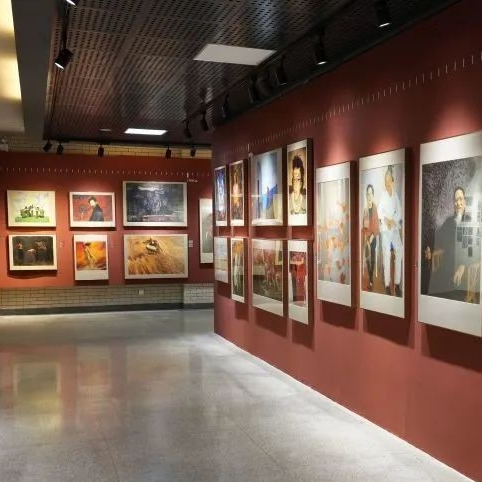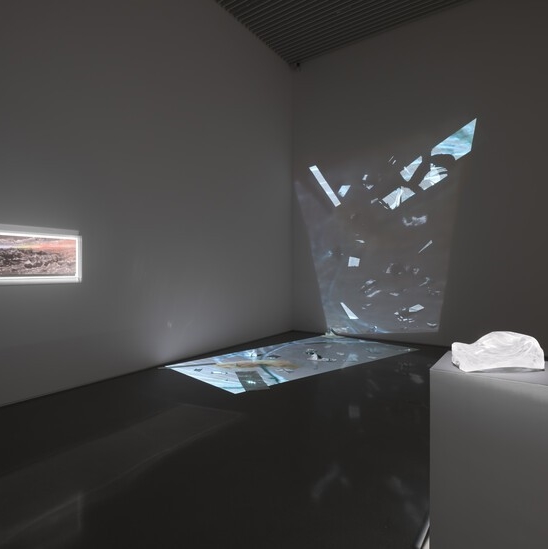On May 1, 2024 CAFA Graduation Season was officially unveiled at CAFA Art Museum. Just as the theme “Direction of the Heart” contains good wishes and sincere expectations for Class of 2024 at CAFA, 2024 CAFA Graduation Season does not only contain their art achievements, their enthusiasm and perseverance in creation are also reflected, which further conveys the imagination and expectations of young students as they embark on the road to the future.


Being is always the being of a being, 2.5×3.5 meters, stainless acid-resistant steel, high-purity iron powder, flexible magnets, stepper motors, gravity slider structure, sound device
 Xie Yuxin introduced her work to the audience.
Xie Yuxin introduced her work to the audience.
Being is always the being of a being
By Xie Yuxin, Printmaking Department of CAFA
I have studied and lived at the Printmaking Department of CAFA for six years. During the process of my creation and study, the relationship between “plurality” and “subjectivity” in the printmaking concepts has deeply attracted me, which triggered my thinking and creative motivations about ontology and existentialism. From my creation with the ontological language of printmaking during my undergraduate period to the undergraduate graduation creation, and further to “Being is always the being of a being”, I persist in explaining the topic of ontological existence from the perspective of ontological concepts. How could we prove the existence of an individual?
 Artist Xie Yuxin
Artist Xie Yuxin

 Being is always the being of a being, 2.5×3.5 meters, stainless acid-resistant steel, high-purity iron powder, flexible magnets, stepper motors, gravity slider structure, sound device
Being is always the being of a being, 2.5×3.5 meters, stainless acid-resistant steel, high-purity iron powder, flexible magnets, stepper motors, gravity slider structure, sound device
When I was a first-year graduate student CAFA, my tutor Li Fan has assigned us research tasks of three books which should respectively center around self-analysis, art case study, and creative clue analysis. In the process of writing about the first book on ego, I analyzed myself from a regional perspective. I was inspired by Georges Didi-Huberman’s book Ce que nous voyons,ce qui nous regarde: The relationship between individual existence and environment is inseparable. Following this clue, I curiously searched for the residence of my hometown (Daqing, Heilongjiang) from satellite images. Familiar streets and familiar lakes appeared in my vision one by one. Due to oil extraction, many villages in Daqing were relocated, so I can also find some traces of human activities on satellite images. I expanded the searching scope and found the problem of landform changes caused by human activities on a global scale.
Eventually, I discovered the problem of gold mining caused by human activities near the Amazon rainforest, as well as the social phenomenon due to the continued rise in gold prices. I attribute this phenomenon to a “material attachment resulting from the uncertainty of the living environment.” So I collected a lot of documents and history about gold and the gold rush period, and found many interesting clues. The process of searching historical materials was like solving a case by a detective.


 The Creative Process
The Creative Process
The creative process for me is also a researching process. After I have conducted many experiments and experienced failures, the final work can be presented at CAFA Art Museum. It is inspired by a dry roll magnetic separator, which was originally used to separate gold from sand. Here I use the operating logic of the original machine to present the problem we have been tracing in the form of three sentences.


 Exhibition View
Exhibition View
The authors of the three sentences are from different generations, regions, and genders. The seemingly anthropocentric discourses are interconnected. These motivations run through every stage of human development even their impact on the future. The melody echoing in the exhibition hall is “Oh! Susanna”. The meaning of this song has continuously changed in the development of human history, from an early love song to a popular song during the period of gold rush. To this day, the connotation of this song is also changing, just like history.
Courtesy of Xie Yuxin, edited by CAFA ART INFO




























